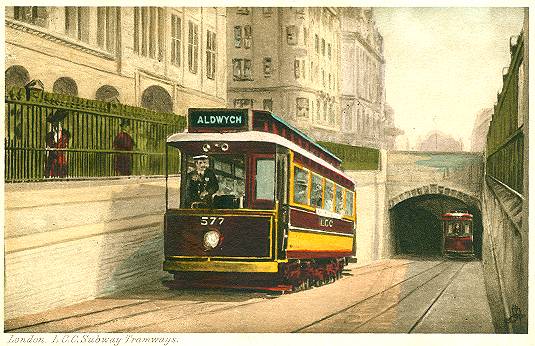

Our postcard shows London County Council Tramways car 577, of class "G". This tram type (cars 568-601) was built in 1906 by The Brush Company of Loughborough, with Mountain and Gibson trucks and British Westinghouse electrical equipment specifically for subway use. It is at the Southampton Row end of the Kingsway Tram Subway around 1907 at which date the subway was in operation only as far as Aldwych, this tram's destination. The subway has already been described, see Kingsway Subway postcard, so this time we will take a look at the postcard itself.
The postcard was printed in Saxony and produced by the famous card publishers, Raphael Tuck & Sons, described on the card as "Art publishers to their Majesties the King and Queen". The card displays the Royal warrant crest, granted to the company in 1893. In the stamp location is the Tuck trademark of a painter's easel with the letter "T" on it. The card also carries this extended caption:-
"LONDON COUNTY COUNCIL SUBWAY TRAMWAYS. A few years ago it was not an easy matter to get from one part of London to another without inconvenience and loss of time. Today however the London County Council's system of well appointed electric tramways makes it possible to travel through the greater part of London and many of the suburbs in comparative comfort and at very little expense."
The card is in Tuck's "Rembrandesque" series. It carries the number 502, but this number in fact refers to the set of cards of which it was a part, rather than the card itself. Tuck's cards were usually issued in sets with a variable number of views in each. Set 502 comprised eleven views of London, but this card is the only one showing a tram. "Rembrandesque" postcards, as with the better known "Oilette" series, were made to look like small oil paintings by retouching the photographic image.
Raphael Tuck was born in Poznan in 1821. Together with his wife and seven children, he migrated to England and in 1866 established a small art and picture shop in Union Street (now Brushfield Street) just off Bishopsgate, London. He was assisted in the business of selling artworks and prints by three of his sons, with Adolph Tuck becoming Managing Director (and later Chairman) until his death in 1926, when the control in turn passed to his two sons. Christmas greetings cards were produced from 1871 and it was Adolph who developed the picture postcard business from its inception in 1898. In the early 1880s branch offices were opened in Paris, Berlin, Montreal and New York. The company moved to various premises in the City of London, finally centring in 1899 on Raphael House built in Tenter Street. Raphael himself had died in 1900, so did not get to see the best of the postcard era. It is thought that it was the influence of Adolph Tuck on the then Postmaster General that led to the increase in the postcard size from 5in. by 3in. to the size allowed by the Universal Postal Union of 5½in. by 3½in. at the end of the nineteenth century and then in 1902 the introduction of the divided back card with message and address together on the one side of the card.
The Tuck business continued to flourish. Sadly in 1940 during the Blitz Raphael house was destroyed by bombing and with it the company records and some 40,000 images. After the war the company moved to London's west end with a branch in Northampton. In 1959 the company merged with two others to form the British Printing Corporation, becoming in 1987 part of the Maxwell empire, which went ito liquidation in 1991 after the death of its infamous owner, Robert Maxwell.
![]() Go to Postcard Of The Month Index
Go to Postcard Of The Month Index